Techniques for processing reconstructed three-dimensional image data
a three-dimensional image and reconstruction technology, applied in image enhancement, instruments, computing, etc., can solve the problems of increasing the cost of creating distinct products for each customer, exceeding the value of custom products, and affecting the quality of the finished product. , to achieve the effect of improving the surface continuity of the polygonal mesh
- Summary
- Abstract
- Description
- Claims
- Application Information
AI Technical Summary
Benefits of technology
Problems solved by technology
Method used
Image
Examples
Embodiment Construction
[0025]Embodiments presented herein provide approaches for creating digital assets that can be used to personalize themed products. For example, one embodiment includes a workflow and pipeline used to generate a 3D model from digital images of a person's face and to manufacture a personalized, physical figurine customized with the 3D model. In this embodiment, a 3D mesh topology of the person's face is simplified to match the topology of the face of a desired figurine. However, while the topology is simplified to match that of the figurine, the 3D model retains the geometry of the child's face. Warping the geometry of the 3D model in this manner allows the simplified mesh topology of the child's face to be integrated with or attached to a mesh representing desired figurine. Doing so results in the mesh of the child's face becoming a sub-mesh of the overall figurine. Alternatively, in some embodiments, the geometry of the child's face could also be warped prior to being mapped to the ...
PUM
 Login to View More
Login to View More Abstract
Description
Claims
Application Information
 Login to View More
Login to View More - R&D
- Intellectual Property
- Life Sciences
- Materials
- Tech Scout
- Unparalleled Data Quality
- Higher Quality Content
- 60% Fewer Hallucinations
Browse by: Latest US Patents, China's latest patents, Technical Efficacy Thesaurus, Application Domain, Technology Topic, Popular Technical Reports.
© 2025 PatSnap. All rights reserved.Legal|Privacy policy|Modern Slavery Act Transparency Statement|Sitemap|About US| Contact US: help@patsnap.com



